Jersey Repeater GB3GJ
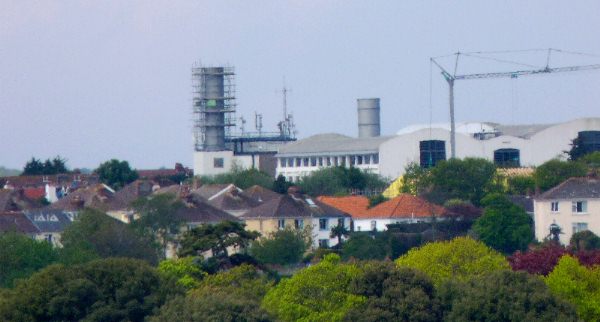
Fact File
Repeater : GB3GJ, Jersey
Thanks to : Jersey Amateur Radio Repeater Group (website...)
via JARS - Jersey Amateur Radio Society (website...)
On air : since 19th June 2010
"Keeper" : Peter B. GJ8PVL
Frequency : 145.6375 MHz (channel RV51 - shared with...)
Input : 145.0375 MHz
(TX shift): -0.6MHz / -600kHz
Mode : FM (for 12.5kHz channel spacing) analogue voice. Digital n/a. Internet links n/a.
Access : CTCSS tone 71.9 Hz (B) required (1750 toneburst n/a)
Time-out : 4 minutes limit per 'over'
After TX : Carrier drops very shortly after end of 'over' - no pips or extended TX
Ident : "GB3GJ B" in Morse every 15 minutes
TX/RX : Tait TB7100, 25W
Antenna : Single Collinear (TRS FVC3-140...), 3dB gain, 3m length
Elevation : 300 ft above sea level
Location : JEC Powerhouse, Queen's Road, St. Helier, Jersey (on Google Maps...)
Locator : IN89WE
dd.ddddd : N 49.19996 W 002.11496 (WGS 84 datum)
dd mm.mmm : N 49 11.998 W 002 06.898
Grid ref. : UTM 30 U 0564474 5450062
WV644500 (WAB WV65)
(a bit off from 05(64)474 & 54(50)062 on the OS map)
|
The regular CW ID is transmitted with the CTCSS tone present, which unfortunately means that there's no "silent monitoring" - you can't avoid hearing the bleeps. This would probably change with the add-on board that may be added eventually which would provide the usual extended TX and confirmation pips like most other repeaters.
That extra board would also solve another little issue. The transmitted audio is EITHER the received audio OR the CW ID. If the ID time comes around while someone is talking, the CW ID will cut in and you will miss a few seconds of the conversation. However, it is possible to TX while the CW ID is happening and grab the audio path, interrupting the CW ID :)
The repeater is a narrow bandwidth one, compared to the old 25kHz spaced system with +/-5kHz deviation. You may notice that if the input signal is too wide, then the repeater's receiver will experience the voice peaks as noise and shut down very briefly, leading to very choppy results!
If you have dual receive and can listen to the input channel and output channel at the same time, you may notice a very slight (but noticeable if you have an ear for audio) echo effect due to the repeater's audio handling which I presume has some DSP trickery going on.
All seems well at the moment, but at one point there appeared to be a slight noise problem on very weak signals, where a crackly buzz sound made borderline signals hard to read, at a level just before the squelch is about to kick in. This made UK contacts slightly more difficult than they should be, but there is a lot of electrical and radio activity at the site so if it happens again it could be tricky to trace the source to remedy this.
Where is it?
If you click on these little photos, the full size version should appear in another window - and may be so big that you'll need to resize or scroll around.

From the beach along St. Aubin's Bay you can see the repeater site on the skyline (about a third of the way along this shot) and appreciate the good view it has.
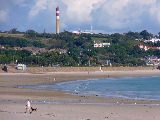
The site is in the top center of this shot, to the right of the Bellozane chimney.
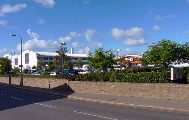
At the top of one of the main road hills into town, there is a retail development that is home to B&Q and the JEC 'Powerhouse'.
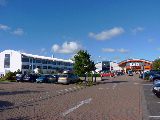
Ample Parking, as the old advertising saying goes.

From here you can see the white GB3GJ collinear antenna.

The site as seen from the lane to the west (not far from the school).
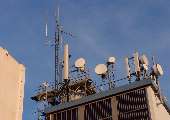
Looking up at the aerials from inside the site.
Coverage - views from the antenna

To the North-East, nothing particularly notable in the distance.

Easterly - The 5 Oaks mast easily visible, and Grainville playing field, St.Saviour's Church.

South-East - Grouville Hill, the Gasworks, Victoria College, and distant Les Marais and Green Island.

South - The other side of the chimney, the Mont de la Ville (Fort Regent), La Collette and new incinerator, around to the mast at Westmount, and Elizabeth Castle in the distance.

South-West - St.Aubin's Bay, including a good view of Noirmont, St.Aubin and fort. On the skyline, the JARS clubhouse at La Moye and the "golfball" radar.
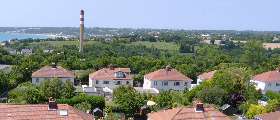
Westerly - including the Bellozane incinerator chimney, and in the distance radar masts and the new control tower at the airport, St.Peter.

North-West - The masts at La Chasse, St.Ouen in the distance, and a good view of St.Lawrence's Church, Parish Hall, and old convent.
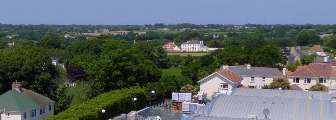
Coming around to North, you can't miss the Fremont Point TV mast.

Passing through North - the Pallot mast up the road at the Steam Museum is exactly in line with the FM Radio masts at Les Platons. To the right of that, the BBC Jersey 1026 AM mast next door to the steam museum.

The North and East of Town in close-up, St.Mark's, St.James's and St.Thomas's Church etc.
It certainly gave me a taste of what the view must have been like from the old Prince's Tower at La Hougue Bie (the tower no longer exists). As Chris commented, they should have put the Jersey Eye big wheel up somewhere with a top-of-the-island view like this!
Path Profiles
Ignore the red lines - these were generated by software that used the Google Maps data for ground level of around 230-240ft at the GB3GJ site. The extra height of the building and mast adds on an extra 60ft or so - bringing the GB3GJ aerial height to 300ft as verified by a few minutes' worth of averaging on my hiker's-type portable GPS. I have added a red asterisk at 300ft on these charts, so please imagine the RF coming from that point.

Local coverage is quite good around the top of the island, with no major bumps in the way. Only the central north area gets significantly higher - just over 400ft.
DX from stations in the UK is hampered by the extra 100ft of granite in the way.

Although Jersey has a number of valleys where line-of-sight is obviously impossible, the
coverage is good along the top of the island, to the north west up to St.Ouen - sloping away gradually in the last couple of miles to Grosnez.

Valleys aside, the other main problem with radio coverage on the island is trying to reach low-lying areas around the coast, shielded by the bulk of the central mass of the isle. This is why Rob RZD had a hard time from Rozel!

To the west it's mainly All Good apart from St.Ouen's Bay being blocked by the land.

Fort Regent gets in the way for a small area around Havre des Pas / La Collette.

To the South-East - at La Rocque the coverage isn't quite so bad, but very much not line-of-sight due to Grouville Hill.

To the East we get good coverage around the 5 Oaks / La Hougue Bie plateau, but the low-lying Gorey Village area is "in shadow".

- although, further to the East, a good signal hits the French coast (Steeve DNI gets in well from Granville marina).

However, it's not looking perfect to Guernsey. They can get into the repeater if they choose (but I haven't heard any try!)
although there's a little bit of Mother Earth in the way at our end,
and it's not helped by Guernsey sloping away from us (profile drawn to a point roughly in the middle of Guernsey - their west and north are low level).

Why you can probably forget about London - major lift or not! The extra altitude of the north of the island, the Cherbourg peninsular, and several ranges of hills are in the way.

It's a better bet towards Exmoor (with obliging tropo), with no other islands, France, or higher chunks of the English South Coast to spoil the party.

Many islanders enjoy French TV from Rennes, assisted by the last mast there. But for normal near-ground level Amateur Radio, the city is shielded from us and out of bounds for direct RF paths.
Their TV mast (to their North-West at St Pern, 178m / 584ft) is 270m tall - making it a combined 448m / 1470ft!

While playing with the path profiler, this explains why FM broadcast reception from North Hessary Tor is so common! Over 1500ft, and not even Guernsey gets in the way.
Also, considering how much the signals vary at the north coast on an average car radio, shows just how important tropo is at that distance even with such a good path.
Anorak's Delight - The Repeater
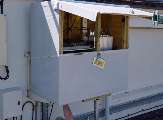
The club members did a great job putting together this wooden box, weather-proofed with Alwitra.
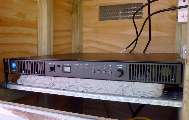
Inside the box, the Tait transceiver.
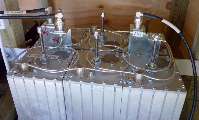
Also in the box, an arrangement of cavities that allows the radio to receive at the same time as transmit, no mean feat through just the
one antenna, and with such a small frequency difference between the TX and RX channels. The very sharp filters also prevent interference to/from other services.

The label on the collinear, in case anyone is interested! Hopefully the antenna will last so long it will be faded to oblivion by the time it needs to be taken down again!

Close-up - GB3GJ's aerial is on the left

Mounting bracket detail, up on the scaffold before the coax was connected up.
Installation Day - Sat 19th June 2010
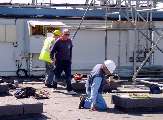
On the flat roof where the repeater equipment box is located.

The mast had 4 levels of scaffolding around it, thankfully - it would have been a vertigo nightmare without that. I lost count of how many times I carried stuff up and down those ladders - and boy did my legs complain about it for the next day or two! It was good to feel useful at last.
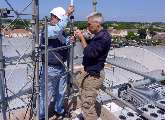
Chris 2J0CMB and Anthony GJ7DTA put the antenna on the bracket in a provisional position.
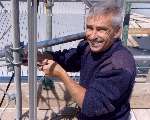
Anthony says "Cheese!" for the camera.
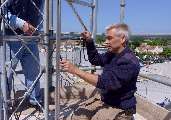
This one got sent to PW Mag, apparently they might publish it.
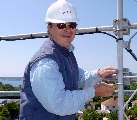
Chris enjoys the work.
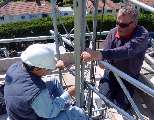
After I help Mike GJ0PDJ to adjust the mounting bracket into its final position, Chris takes over from me to help him finish the spanner work while I "capture the moment".
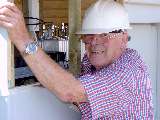
Dieter MJ0CYD at the box.

A group photo without enough warning rarely works out well! They blink, I miss it.
Mike 2J0SZI, Dieter MJ0CYD, Mike GJ0PDJ, Chris 2J0CMB, Anthony GJ7DTA.
GB3GJ was up and running at about 4.10pm, and as no-one else had a radio up there, I put out the first test calls. Nobody was around though, and it took until about 4.50pm until the first QSO between me and Steve MJ0SIT, which proved that it was working, much to our relief.
A number of French stations have made it successfully into the repeater, but it wasn't until Sat 4th Sept 2010
that an English station managed a QSO. Our impressive local collection of Steves were on air when Dale 2E0OPS came through, followed shortly afterwards by yet another Steve, G6SQX!
Final Touches - Tues 22nd June 2010
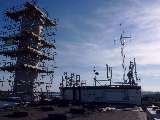
An evening visit for three of us.
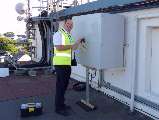
Rob MJ0RZD at the box.
A temporary safety strap was removed this evening, and the coax was shortened - those 13 turns of spare cable probably added about 10m's worth of unwelcome extra loss. Even with milspec RG213 cable we're better off without loosing any signal for no good reason.
Hooking up a handheld radio and test meter gave us a welcome low VSWR reading and comforting access of a couple of UK repeaters.

Some final earthing arrangements were sorted out too, by Mike 2J0SZI and Rob MJ0RZD. Then we switched it all on at exactly 8.15 so that the quarter-hour idents were on time - even if it does seem to lose a second per day, hehe.
Earlier - Sat 8th May 2010
Having heard that people wouldn't be allowed to the repeater site without a short introduction to site safety a the JEC, luckily I found the time to go along. I was glad I did, because I could then tag along to the Work Party where I tried to help, but couldn't do much really! Carried a thing or two, but mainly just watched the practical types doing their drilling and cable-tray work. But I hoped I added something in my unique way, LOL. Oh, and I took these photos..... some of which appeared on Rob MJ0RZD's websites and JARS newsletter.
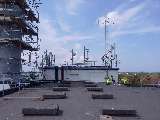
Up on the roof before anything changed - the original three old disused Low Band PMR antennas on the mast, no cable tray yet, no box in place.
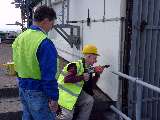
Joe (SWL at the time) drills the first hole. He put of lot of good work in - well done Joe.
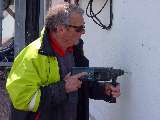
Mike gives it some hammer action.
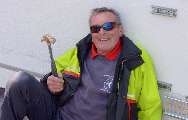
- and again.
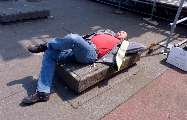
Rob takes a well earned rest for a moment.
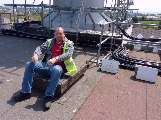
- and then realises my camera was on him :-)
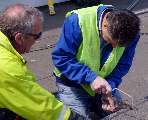
Chris wields a saw.
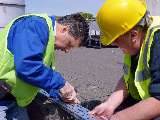
- and proved that he was not all that much slower than the powered version, getting through the cable trays!
Well done to everyone who helped to get the Jersey repeater back on the air. I'm impressed with all the work put into this project, in a relatively short time it all came together well. I'm sorry I didn't join in with the planning and management aspect of it, but as a single dad my free time is in short supply so I don't get to do committees and suchlike. I have tried to do what I can to help in my own way, whether it was noticed or not. Donations to running costs? Let me see how much I want use it, first! :)
























































